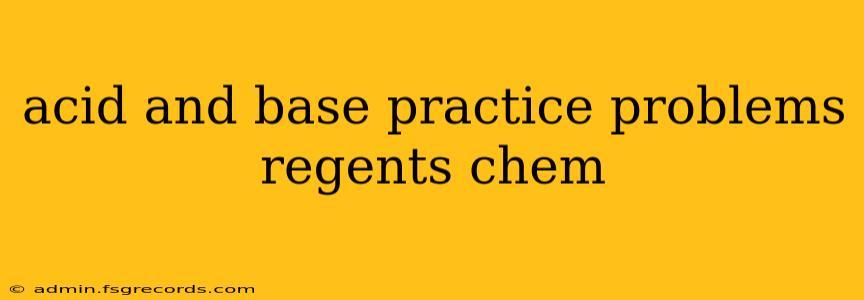Preparing for the Regents Chemistry exam can feel overwhelming, but mastering acid-base chemistry is achievable with focused practice. This guide provides a range of practice problems mirroring the difficulty and style of questions you'll encounter on the exam, complete with detailed solutions. Understanding these concepts is crucial for success. Let's dive in!
Understanding Acids and Bases
Before tackling the problems, let's quickly review the key concepts:
- Arrhenius Definition: Acids produce H⁺ ions (protons) in aqueous solutions, while bases produce OH⁻ ions (hydroxide ions).
- Brønsted-Lowry Definition: Acids are proton donors, and bases are proton acceptors. This definition expands the scope beyond just aqueous solutions.
- pH Scale: A logarithmic scale indicating the acidity or basicity of a solution. A pH of 7 is neutral, below 7 is acidic, and above 7 is basic. The formula for calculating pH is pH = -log[H⁺].
- Strong vs. Weak Acids/Bases: Strong acids and bases completely dissociate in water, while weak acids and bases only partially dissociate.
- Neutralization Reactions: Reactions between acids and bases that produce water and a salt.
Practice Problems
Here are some practice problems covering various aspects of acid-base chemistry:
Problem 1: Identify the Arrhenius acid and base in the following reaction: HCl(aq) + NaOH(aq) → NaCl(aq) + H₂O(l)
Problem 2: What is the pH of a solution with a hydrogen ion concentration ([H⁺]) of 1 x 10⁻⁴ M?
Problem 3: A solution has a pH of 9. Is this solution acidic, basic, or neutral? What is the pOH of this solution? (Assume 25°C where Kw = 1 x 10⁻¹⁴)
Problem 4: Classify the following as strong or weak acids/bases: a) HNO₃, b) HF, c) KOH, d) NH₃
Problem 5: Write the balanced neutralization reaction between sulfuric acid (H₂SO₄) and potassium hydroxide (KOH).
Problem 6: A 25.0 mL sample of 0.100 M HCl is titrated with 0.150 M NaOH. What volume of NaOH is required to reach the equivalence point? (Hint: Use the stoichiometry of the balanced neutralization reaction).
Solutions & Explanations
Problem 1: HCl is the Arrhenius acid (produces H⁺ ions), and NaOH is the Arrhenius base (produces OH⁻ ions).
Problem 2: pH = -log[H⁺] = -log(1 x 10⁻⁴) = 4. The pH of the solution is 4.
Problem 3: A pH of 9 is basic. Since pH + pOH = 14 at 25°C, the pOH is 14 - 9 = 5.
Problem 4: a) HNO₃ (strong acid), b) HF (weak acid), c) KOH (strong base), d) NH₃ (weak base)
Problem 5: H₂SO₄(aq) + 2KOH(aq) → K₂SO₄(aq) + 2H₂O(l)
Problem 6: First, write the balanced equation: HCl(aq) + NaOH(aq) → NaCl(aq) + H₂O(l). At the equivalence point, moles of HCl = moles of NaOH. Moles of HCl = (0.100 mol/L)(0.0250 L) = 0.00250 mol. Therefore, moles of NaOH = 0.00250 mol. Volume of NaOH = (0.00250 mol) / (0.150 mol/L) = 0.0167 L = 16.7 mL.
Further Practice & Resources
These problems offer a starting point. To fully master acid-base chemistry for the Regents exam, you should:
- Review your textbook and class notes: Ensure a solid understanding of the fundamental concepts.
- Work through additional practice problems: Utilize your textbook, online resources, and past Regents exams.
- Seek help when needed: Don't hesitate to ask your teacher or tutor for clarification on challenging concepts.
Consistent practice and a clear understanding of the underlying principles will significantly improve your performance on the Regents Chemistry exam. Good luck!

